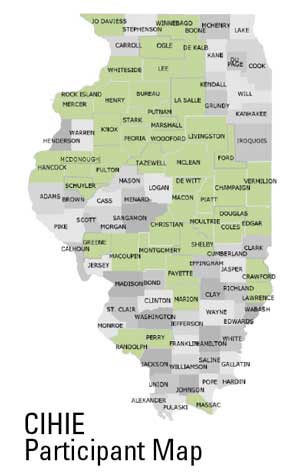CIHIE provides new opportunities for patient-centered planning and quality improvement.
As healthcare providers across the nation wrestle with changing payment structures, new technologies and tightening quality metrics, the search for ways to better coordinate patient care has never been more intense.
Communities of Illinois Health Information Exchange (CIHIE), formerly Central Illinois Health Information Exchange, plans to be part of the solution with the creation of a statewide network for care notifications when patients have unplanned medical encounters such as emergency room visits and hospital admissions or discharges. The new network allows real-time notifications to be sent to a patient’s primary healthcare provider or other member of the clinical care team so that appropriate aftercare can be arranged.
Making it possible for healthcare records to seamlessly follow a patient across healthcare settings has been CIHIE’s mission since the nonprofit organization was established in 2010.
Those involved in planning for the health information exchange point to changing expectations as a key driver. When a patient sits in a doctor’s office and sees information being entered into a computer, it’s only natural to wonder why all the same information needs to be repeated to the next doctor.
Today, more than 70 hospitals, 400 primary and specialty care practices, long term care, home health and other provider settings participate in CIHIE’s services. From secure messaging to electronic record queries and most recently, real-time care alerts, health information exchange is changing the way healthcare is delivered. These changes aren’t only happening here in central Illinois.
A National Movement Toward Care Coordination
The challenges of care coordination are not a new problem. In 2008, the Institute for Healthcare Improvement first established three key goals for national healthcare, commonly referred to as “The Triple Aim.” The goals include:
- Enhancing the patient experience;
- Improving population health; and
- Reducing the increase in the cost of care.
In the decade since, technology has become increasingly important. The disappearance of paper charts was likely the most noticeable change for patients, but behind the scenes, the changes required of healthcare providers and technology vendors have been sweeping. New accreditation requirements, utilization standards, financial incentives and progressive penalties have all been part of the national roadmap.
The need for coordinated care becomes even more critical when patients have lengthy or complex care histories, or conditions which prevent them from accurately conveying information about their medical care. These patients often see multiple specialists, receiving therapies and services in numerous locations where technology systems are disconnected.
Research has demonstrated that Medicare beneficiaries with 10 or more chronic conditions were six times more likely to be readmitted for hospitalization. While they represent less than nine percent of all Medicare beneficiaries, they comprise more than 50 percent of all hospital readmissions.
Greater awareness of patient interaction along the care continuum, coupled with addressing complex patients earlier, is proving to be an important part of finding a fix.
Care Notifications: An Early Warning System
In mid-2016, CIHIE received funding through a national grant to make care notifications available to healthcare providers in Illinois. The notifications focused on unplanned encounters such as emergency room visits, as well as inpatient admissions and discharges.
The underlying premise is that unplanned encounters are often an early warning sign for more expensive encounters. If primary care providers or other care coordinators are made aware of these events, they can intervene to be sure an appropriate care plan is in place, perhaps avoiding future hospitalization. Without timely follow-up, the result is often another emergency visit or hospital readmission.
CIHIE’s notification network officially launched in November 2016. Almost immediately, the participating providers began reporting positive results for patients.
One of the first examples emerged out of Illinois CancerCare, where a notification came in about a patient arriving at the hospital with symptoms of dehydration after receiving chemo treatment. Historically, the cancer treatment team would not have known about the complication until the patient returned for a future visit—and that’s only if the patient remembered to tell them. In this case, notification allowed the team to do proactive planning, which should avoid hospitalization in the future and provide the patient with a more positive care experience.
Stories like that make the benefit of the technology feel real.
CIHIE’s early experience with notifications is being echoed nationwide. ADT (Admission, Discharge and Transfer) notifications are now in place in many states across the country, and more research has been planned to assess the value of this functionality.
Multiple studies are being conducted at Veterans Administration (VA) sites across the U.S., including the Bronx in New York City and Indianapolis, Indiana. At each site, the VA partnered with the local HIE network to receive event notification alerts for its patients. Upon receipt, VA clinicians follow up with veterans to better manage their disease processes and health.
Researchers for the Bronx study found evidence of higher readmission rates without notifications and a 2.9-percent reduction rate in the probability of a readmission when notifications were available. This research is continuing at the Indianapolis VA location, with a larger population of patients to provide more information on the benefits of ADT notifications.
The Future of Care Coordination
Real-time care notification is a promising example of how technology can support more effective and efficient care, while improving the overall patient experience. Yet, most health information exchange approaches are still in early developmental stages.
In the years ahead, we’ll see an emphasis not only on getting information to flow securely between providers, but also making it more actionable through smart workflows and data analytics. iBi
Joy Duling is executive director of Communities of Illinois Health Information Exchange. She has orchestrated the planning process and daily operation of the organization since 2009. For more information, visit CIHIE.org.


